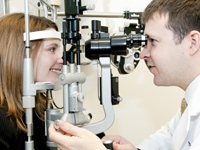In the United States, glaucoma is second only to cataracts in the causes of blindness. With cataracts, the cloudiness that causes vision loss can be repaired and lost sight restored. The nerve damage and subsequent blindness caused by glaucoma, however, is irreversible.
"Everyone is at risk for glaucoma," said Dr. Nathan Radcliffe, assistant professor of ophthalmology at Weill Cornell Medical College. "My job as a glaucoma specialist is to reach out to those who are at a higher risk and to prevent them from losing vision to this irreversible disease."
In an effort to raise glaucoma awareness at Weill Cornell and beyond, the Department of Ophthalmology and Dr. Radcliffe hosted World Glaucoma Day on March 12 at the Weill Greenberg Center. Free glaucoma screenings were given to more than 100 people, and Dr. Radcliffe led a public informational session in the Myra Mahon Patient Resource Center afterward. Later that evening, Dr. Radcliffe also lectured at a Grand Rounds for ophthalmologists in the New York area.
It is estimated that about 60.5 million people worldwide have glaucoma, 6.7 million of whom are blind in both eyes. In the United States, approximately 4 million people are afflicted with glaucoma, although, because one eye can often compensate for vision lost in another, half of those affected aren't even aware of it. Often, with the glaucoma eye, sight loss begins with reduced peripheral vision, and is not immediately noticeable.
Glaucoma was initially thought to be a disease caused by high eye pressure to the optic nerve. Researchers now know that it is possible to have normal eye pressure and still develop glaucoma. Moreover, high eye pressure does not necessarily lead to glaucoma.
Family history is a factor in diagnosing glaucoma, as is the patient's race, though doctors are not sure why. Currently, about 10 percent of African-Americans over the age of 70 have glaucoma. That percentage doubles with African-Americans over the age of 80. Those numbers are roughly four times the amount of Caucasians in the same age groups that suffer from the disease. The rates of Latinos with glaucoma are even higher.
Regardless of race and family history, glaucoma cannot be self-diagnosed. It is essential that patients be tested by a physician who can begin treatment before total blindness sets in.

Dr. Nathan Radcliffe (right) adminstered free glaucoma screenings during World Glaucoma Day, March 12.
"We have great treatment for slowing or stopping the damage. And we can prevent any vision loss if we feel a patient is at risk," Dr. Radcliffe said, "But currently there is nothing we can do to regenerate that lost vision."
Many glaucoma sufferers require daily eye drops as treatment. More extreme cases call for laser surgery or more invasive procedures to help reduce the intraocular pressure.
As the treatment options for glaucoma have improved, so too have the testing procedures. Eye pressure is still checked at every visit, but since high eye pressure does not always result in glaucoma, other methods have been developed. One approach is to simply take a photo of the back of the eye. By comparing new images against the initial photograph, doctors can see if the optical nerve has sustained any damage. Visual-field testing is also an effective monitor of a patient's changing scope of sight.
"More than anything, glaucoma is a disease of change," Dr. Radcliffe said. "Only in the glaucoma eye, do things change over time."
Photography by Amelia Panico.

